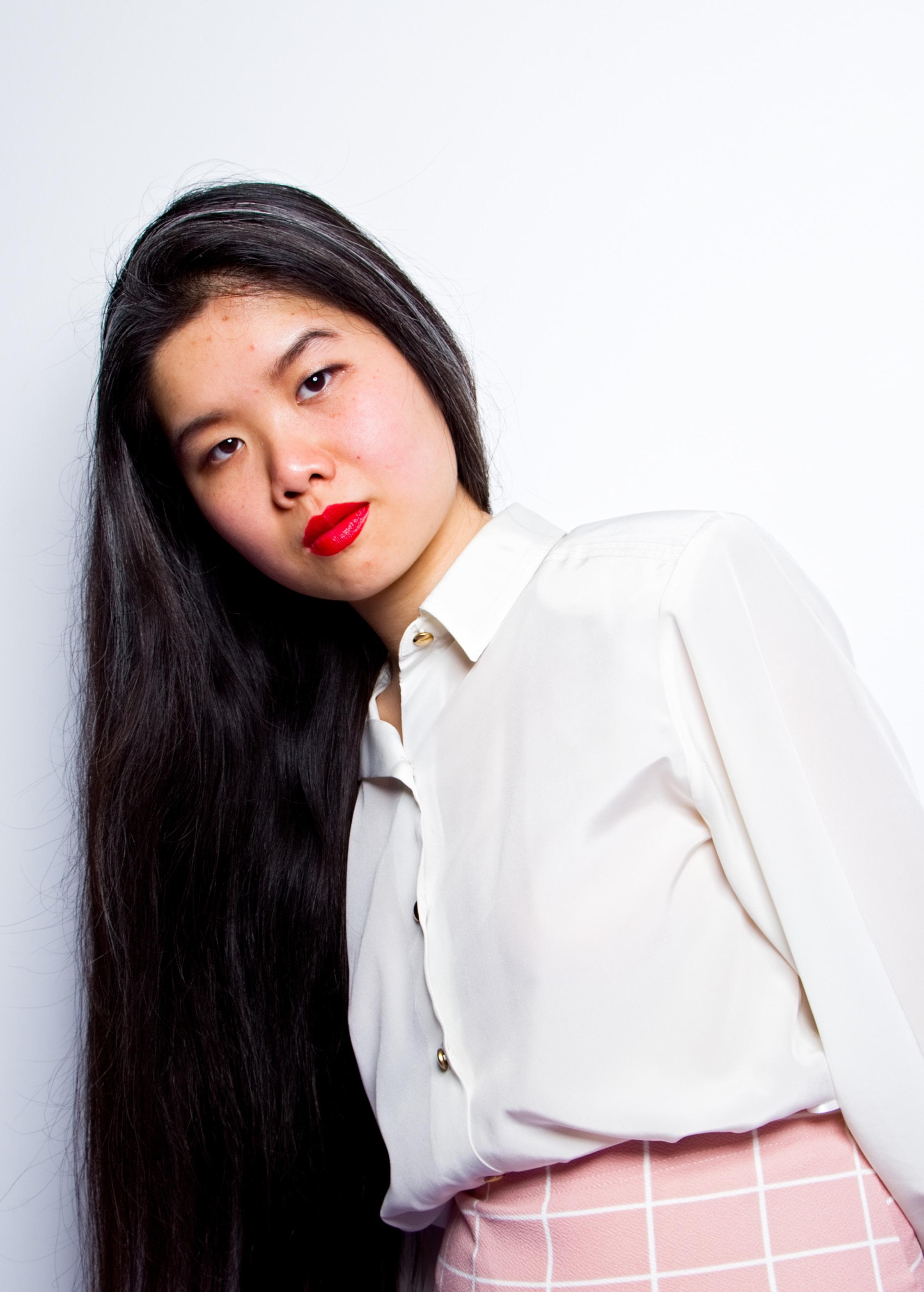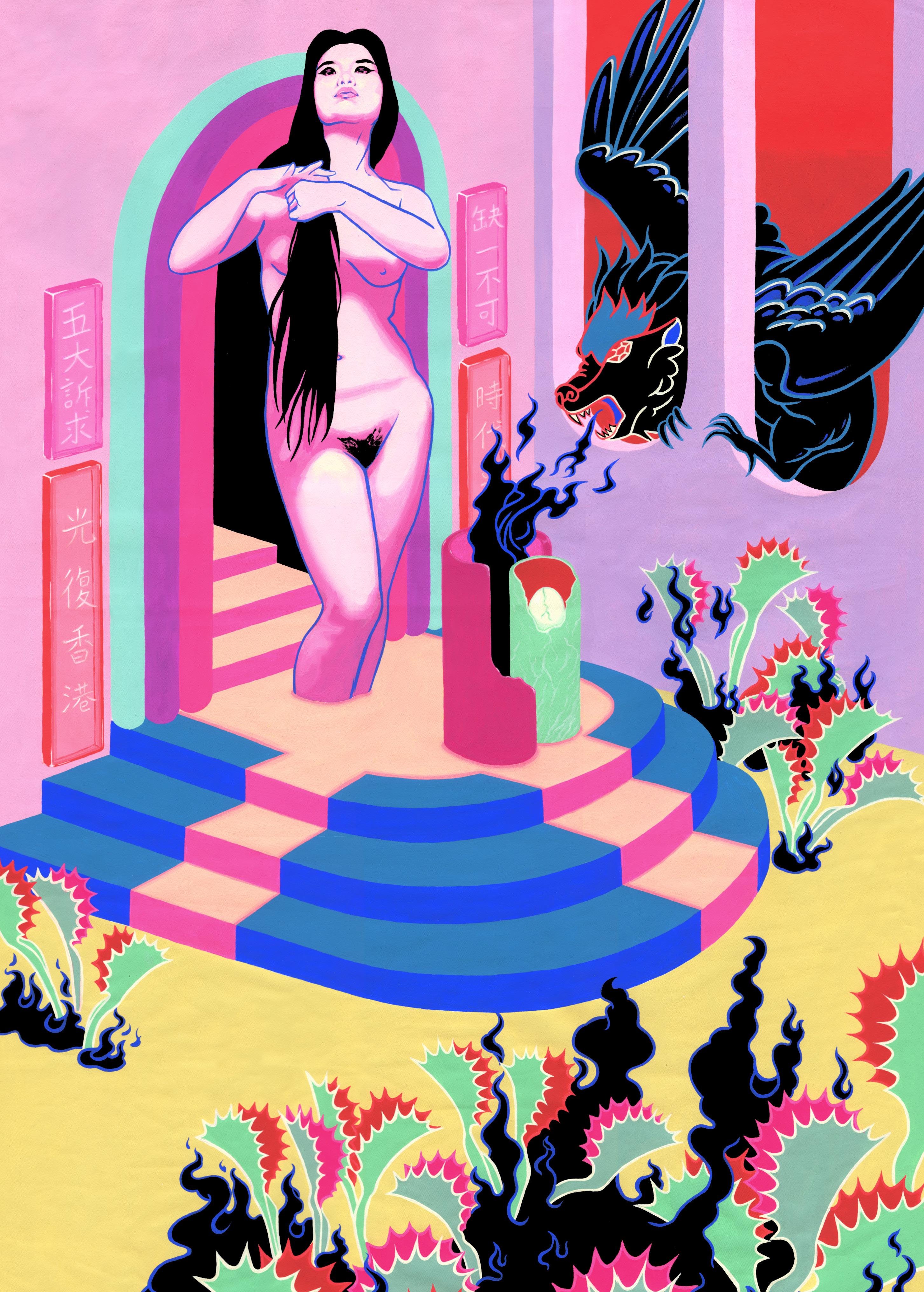
25 minute read
Tsz Kam
made, and you can’t help but see they are created in one specific aspect of self. I’m convinced this is the path for me because I always felt like I have more control of my life than anyone or anything else does. So anything that supports that logic for me I’m all about. It’s kind of funny, being on the other side of what people think Satanism and the left-hand path is, I can’t help but smile. When we were talking about multidimensional and it being more internal, one of the multidimensional practices I have for myself is knowing when it’s time to work on something. Like a challenge that comes up. So I am divorced and dating, and one of the challenges that came up with my dating life recently was learning to be comfortable with being alone. Building myself from there, because before I was building myself as I was. I was married when I began this practice and now that I’m not married and not in a relationship, it has been a challenge for me to further establish my identity as myself. I moved into my own apartment in July, and ever since then I have done everything I can to make it mine. And that included getting rid of every single thing my husband and I shared. So in doing that, I’m creating an atmosphere around myself that feels like a cocoon for me. It’s like my identity is everywhere. There is nothing left of me as a married woman, so that person is gone, but her experiences now come forward, and I am honoring that as the evolution I am experiencing right now.

Advertisement
We are multidimensional as individuals, where each person is a separate entire universe and they create their own universe with their own thoughts, actions, beliefs, and rituals.
Obviously the whole process of going through the divorce woke some of those feelings up. Was there something in the finality of it that that also woke something up internally?
T: You know, it’s funny you ask that because yes, it did awaken that. When I started my spiritual journey experience, I was staying at home. And while my husband and daughter were away at school and work, I was meditating pulling cards, taking a spiritual course to get in touch with my intuition, journaling, crying. It was everything. All of that went on for about three years, [and] all of that brought me to the point where I was able to see that my ex-husband and I weren’t in alignment, and it empowered me to acknowledge, “hey, maybe it’s time to let that go and become an independent person again.” Because there was a lot of friction between me and where I was as a powerful [and] independent woman -- even though I was married. And my ex-husband who is probably like, “who is this person? This is not who I married.” My ex-husband and I are really good friends, and the divorce was so easy and peaceful. We didn’t even have attorneys, we just did it online. The day we went to court to finalize [the divorce], we had lunch before we went and afterwards, we went and hung out on South Congress together. It was like no big deal, and he let me live with him for some time so I could save up money. So when I did move, I was able to spread my wings entirely. When I moved into my apartment, I was like, “this is all mine!” So I systematically begin to replace things one at a time with things that were authentic to me. It’s funny, my ex-husband will come over to drop off my daughter and will be like “wow this is really cool,” and I’ll look at how he redecorated the house and think “that’s pretty badass”, so we’ve both grown and it’s kind of fun for our friendship.
That’s really refreshing to hear. We hear so many stories about how ugly divorce can get.
T: It can be a bear, but it doesn’t have to be. If the two individuals are not totally narcissistic and really try to make things peaceful, not only for themselves but realizing, “I am connected with this person until I die, because I have a child with this person,” and in some capacity or another you’re going to have this person in your life, so it’s worth it to try and make the relationship work. Just in a new direction. So we’ve become fantastic co-parents and even better friends than we were before. We text each other all the time sending pictures of cool furniture we found, and it’s like, “this is good, I like this better.”
Now you’re building on what I believe you said was loneliness but it’s independence from not being in a relationship or marital relationship?
T: Yes. So now I feel I have released an archetype of being a wife and come into the archetype of independent single female. And with that comes a lot of realization. Like that you
don’t have to compromise with someone or ask for permission to do something. The first time I felt that is when I bought the dishes, I was like, “oh! I can buy stuff that he never would have liked!” When I met him I was in my early twenties. I was just a baby, and I hadn’t really gotten to the point in my life where I was in touch with myself. So I made the mistake a lot of women make of “marrying my father”, and he was very father-like in our relationship. He would do a lot of things for me, and a lot of times it kept me from growing. So fear, for a little while, kept me from separating, because now I have to do this shit by myself. I thought “I would so much rather do that than continue on in this way.” So releasing him was probably the best decision I ever made for myself, and that’s to say he’s not a bad person, he’s just not right for me. Honestly, I don’t think I was very right for him either. He went on to date a woman who’s more like him, and I feel like he’s more comfortable and he seems happy.
It’s very interesting you said that multidimensional was inside of us, and now we’re discussing a very different side of you. We haven’t even spoken about tarot in a hot minute! There’s so much of a universe inside of us and we’re almost switching planets in the Tiffany universe. From tarot and divination. Now, to a part of Tiffany involving relationships with others, romantically, platonically, being a parent, co-parenting. It’s really solidified that idea, that there could be stuff beyond us but there is a whole universe in us.

T: Exactly! And one of the things about tarot reading that echoes that is the archetypes. In the whole deck, there are different aspects of personality. And whenever you draw those cards, it’s asking you to focus on that aspect and how it pertains to your question. Or it can help you formulate a question for your question whose answer is the answer.
That sounds like a complicated math problem
T: *Lets out a laugh* It kind of is, because we’re complex individuals. If you’re familiar with Carl Jung, he brought archetypal energy into psychology, and that’s where the inner dimensions really rule. In that logic, we all have those different roles that we play in our lives. We take off that “I’m working” hat and put on the “it’s happy hour and have some fun with your friends” hat. Some evenings you put on the “parent” hat and when you go to work you put back on your “work” hat. Whenever it’s time for you to set one aside to focus on the other, sometimes there’s a little bit of shadow within that archetype that challenges you as a whole. With relationships, my challenges with loneliness have really helped me to discover ways to enjoy time by myself. As well as understand that the reason I’m alone right now is because I need to be to get back in touch with who I am, without being a wife and a partner. So whenever I do reenter another relationship, I will have that connection. We have a tendency to lose that when we’re in a relationship we tend to mind-meld with our partners and become a singular mind. Having this time gives you an opportunity to solidify that you are just you, and they are another person. Our two universes are in a collision working together, and it’s easy to lose sight of the fact. I wanted to talk about when I read people what I find myself doing is showing people who they are by asking them questions and I help them arrive at the conclusion with the answers, it’s called the Socratic method, basically what I do when I lay the cards down and have a conversation about what that could mean to them and their current path. I start to realize,“so this is what their world is like,” and I can see where they need to focus on self-development. So then I ask questions that help them arrive to the conclusion they need to be at. A lot of times it’s people overcoming indoctrination and the conditioning of their families and all of those things to really focus on self-development, because nobody really wants to do it because it’s challenging. When you think of self-development, it’s more than just virtual, it is challenging everything you’ve ever been taught and starting over again. So I kind of guide people in that direction, like “this is what needs to happen for you to feel better about the situation.”
You said when you started practicing professionally, it was not too long after you started doing the practice for yourself. Are there any situations or scenarios when you read for other people where it starts something in you?
T: Yeah, because any time you talk to someone about their situation you can’t help but compare to your own. A lot of times, if you’ve been through that situation and you have some solid advice on how to get through to the other side, especially when it’s emotionally challenging, it helps you empower other people. And it helps you to challenge yourself because there are going to be people who come to you with their own set of beliefs, and you have to put ego aside and open up and receive. Everyone has a gift of perspective to give, and I’m here to receive.
Do you still get a lot of people who come to you with the intention of thinking you read the future?
T: I do and I have to remind myself that everyone is on a certain path, and they are on a certain place on their path, and it’s not my place to judge. If they haven’t figured out what tarot is yet, it could very well be it is up to me to introduce them. I do so with grace and I’m polite and patient, and they’re like, “this is so cool,” and boom I’ve created another tarot reader! And someone is going to discover the beauty of reading for yourself and growing from that. I always try to be really cool and really open and let people take what they want from it. Because the last thing I want anyone to feel when they come to me is judgment. We all deal with enough of that shit already, and there’s not going to be any of that at my table.

By: Monica Valenzuela Photography by: Jinni J Illustrations by: Cristin Cornal

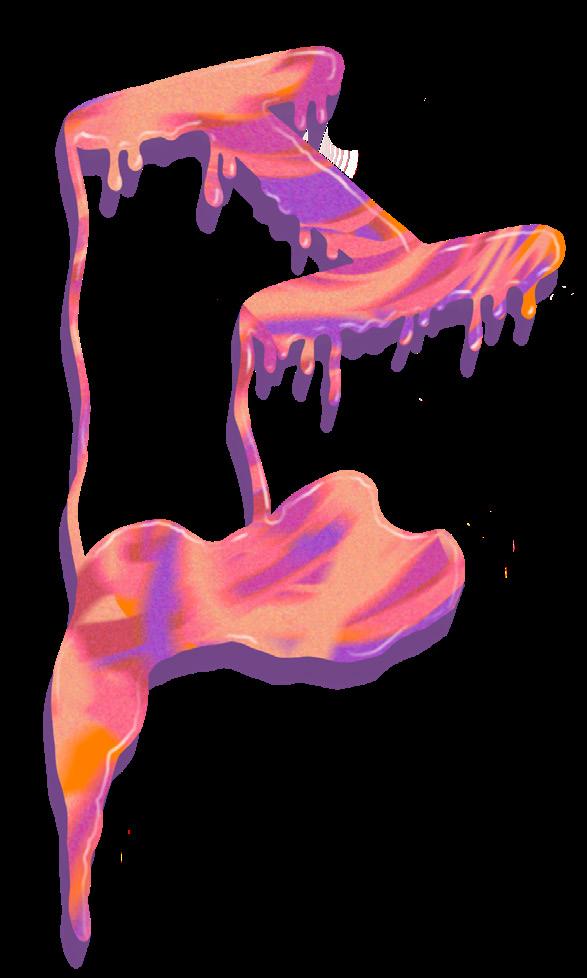
was on my way to visit a friend at a tea shop during The East Austin
Studio Tour. The tea shop was located in a new development off of Springdale road. The concrete parking lot looked freshly-painted.
There were only a few vacant retail spaces with for-lease signs. The rest of the development had brought in niche shops that fit in well with the type of demographic East Austin had created. It was Saturday afternoon, and
I kept complaining that there were too many people out and about. A usual complaint I always make in a city with a population of over one million. As I’m navigating through groups of pedestrians to find my destination, I’m caught off-guard by a bright mural on a large grey steel wall.
The familiarity of the mural gives me a sense of calm in the crowd. I smile very wide while a large yellow macaroni noodle stares right back at me.
I must get this straight. I’m not new to the noodle. The mural I had seen was by local artist Tsz Kam. I had actually been obsessed with Tsz for some time. I first discovered them at a local Bossbabes event. They were a featured artist, and what drew me to their work wasn’t just a noodle. It was everything that surrounded the noodle. The vibrant colors popped off the canvas. The pigment of the paints looked otherworldly, as if Tsz flew out into the solar system and hand-picked rare elements to mix into their acrylics. The subject matter they created could be anything from plants to creatures to their own image, and somehow make perfect sense or no sense at all.
Reaching out to Tsz for an interview felt right. Not only did I love their art, it was really the main inspiration for the topic of this issue. Visually, each piece that I had seen done by Tsz sent me to another place and time. I use the word multidimensional because I didn’t just have one feeling when looking at their work. I would feel multiple things, or would see so much. I could see myself tucked away in the armpit of a creature or see myself nestled softly in neon-colored plants. I could fall asleep in their art, and I could stay there forever.
Tsz wanted to meet at their place for the interview. Their art had become their full-time job. They worked from home and felt comfortable in their makeshift studio. They had been working on new art for an upcoming show and wanted to show me what their process looked like. They even offered to make me lunch. As a hungry pregnant lady at the end of her second trimester, I wasn’t going to turn down a free meal.
I show up to their place late as usual, but they don’t seem to mind. I’m greeted by Tsz at the door and they are warm and welcoming. They show me their living room which doubles as their studio. I see semi-exposed canvases and small heartshaped containers full of paints. We head to their kitchen where Tsz already has lunch waiting. On the menu is turmeric chicken salad sandwiches, spring mix salad, roasted carrots, and macarons for dessert.
Tsz starts to explain, “I used to work for this fancy restaurant where they made this chicken salad, and they added turmeric to it, so any time I buy chicken salad I have to add turmeric to it. I can’t have it just plain.” They serve me a plate with food and I dig in. I kind of forget why I’m there besides eating. After a few bites I snap back to reality. Oh, yeah I’m here for an interview.
I start recording, and our casual conversation shifts its focus to a more serious tone. We talk about math: a subject I’m not a fan of but seems to be Tsz’s strongest ability. In ninth grade, Tsz started attending North Shore High School in Houston, Texas. A school known more for its football and not much else. During their time at North Shore, Tsz would help take the mathematics team to UIL (University Interscholastic League) and win a state championship.
Excelling at the American school standard came easy to Tsz. Coming from a culture that always emphasized education, it seemed pretty drastic how different high school in Hong Kong was versus Houston, Texas. “Chinese people invented
civil service exams which pretty much is what the SAT and all standardized tests are based off of. So the culture I grew up in, we believe in testing for the best and brightest people to join the workforce and to help lead. When I came to the United States, I was already in my second year of secondary school (in Hong Kong it was based on the UK system). So since the system was different here in Texas I felt I was ahead in the type of education I was receiving.”
Tsz moved to Texas from Hong Kong in 2007. “My grandpa always wanted someone from our family to study overseas. Actually, that’s what he wanted for himself, but he never had that chance. I look up to him a lot. I wanted to be him. I wanted to make him happy and impress him, so I decided to come by myself. I had aunts who lived in Houston and so I got a travel visa and made my way over here. My aunts at the time had offered to adopt me but things fell through, and it ended up not working out. School ended up keeping me here. I started going to college and was able to stay here because of it. I was unsure how to get citizenship here. Time passed, and I thought maybe marriage, haha. That’s how a lot of people get citizenship, but I’m not ready for marriage. This art thing seems to be working right now. I’ll just keeping going with that.”
The impact that Tsz’s grandpa had on their life wasn’t just about visiting the United States. Tsz wanted to encompass everything that their grandfather was. By the time they were born, their grandfather had essentially retired allowing unlimited time together. Tsz’s parents worked late nights and early mornings at a night club leaving Tsz to be raised by their grandparents and their uncle.
“I lived in this strong male-figure household: my grandfather and my oldest uncle. I was never intimidated by this traditional patriarchal set up. I just wanted to be like them. My grandfather had came to Hong Kong from the southern region of China in a time where things were constantly changing politically but also had an affect on how people were viewed. My grandfather was seen as scholarly and he wanted to continue that image for his family. I wanted to become that. He would share stories with me and ideas that he never told anyone. I felt special in knowing that I could be his legacy.”
Tsz’s ability to excel in school was met with de
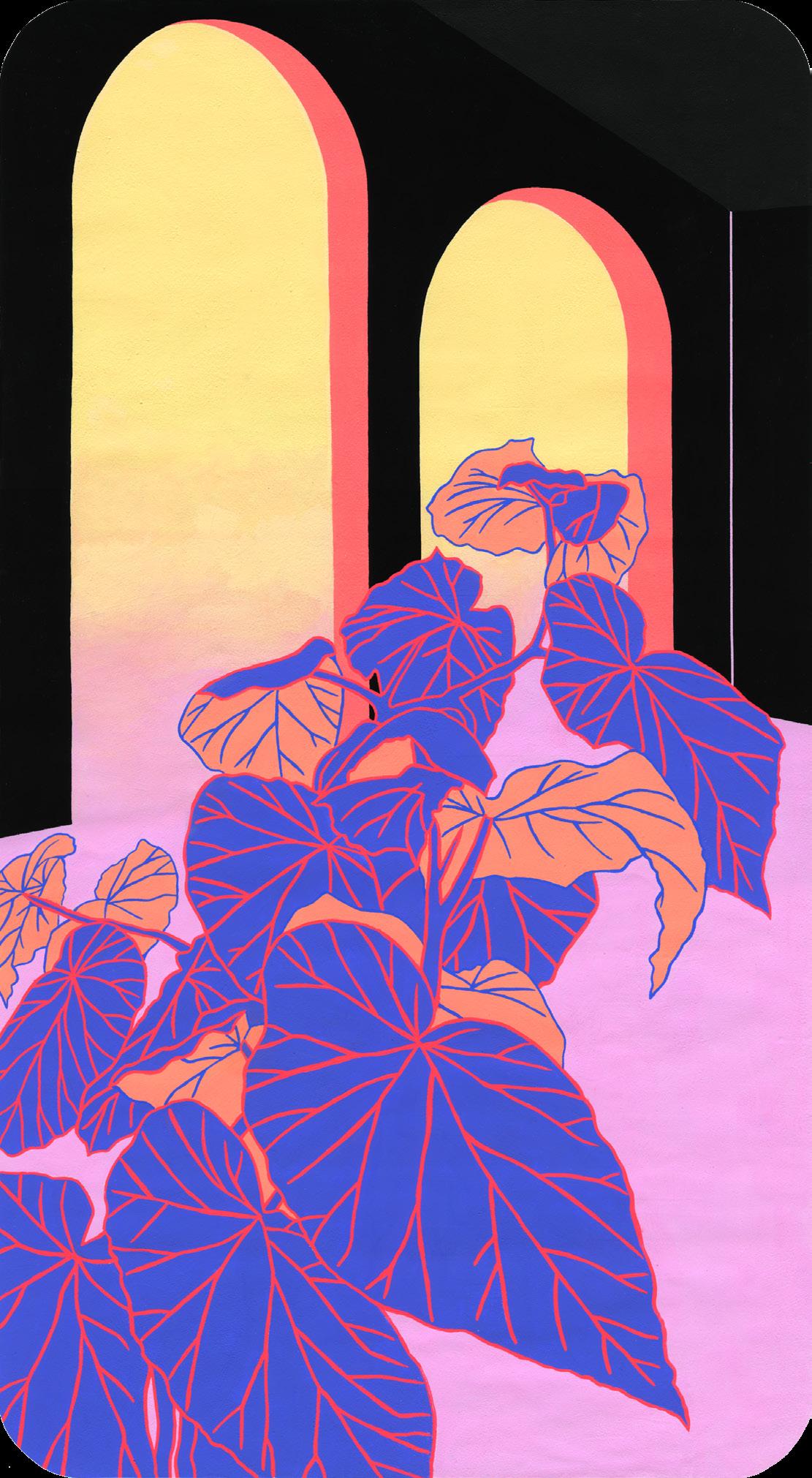
termination from their family. It was never something that felt forced or even something they second guessed about themselves. They wanted to do well and make their family proud. That mentality continued well after moving to the United States.
“I feel like early on in high school a lot of teenagers have trouble fitting in or trying to find out who they are, I never dealt with that. For me it was the opposite. I knew who I wanted to be, I knew who I was, I know my mission, I’m here to impress these people and show them how great I am. Because that’s what my grandfather showed me. It wasn’t until I was around seventeen that I started questioning my identity. My grandfather actually passed away right before I graduated high school. After he passed, I
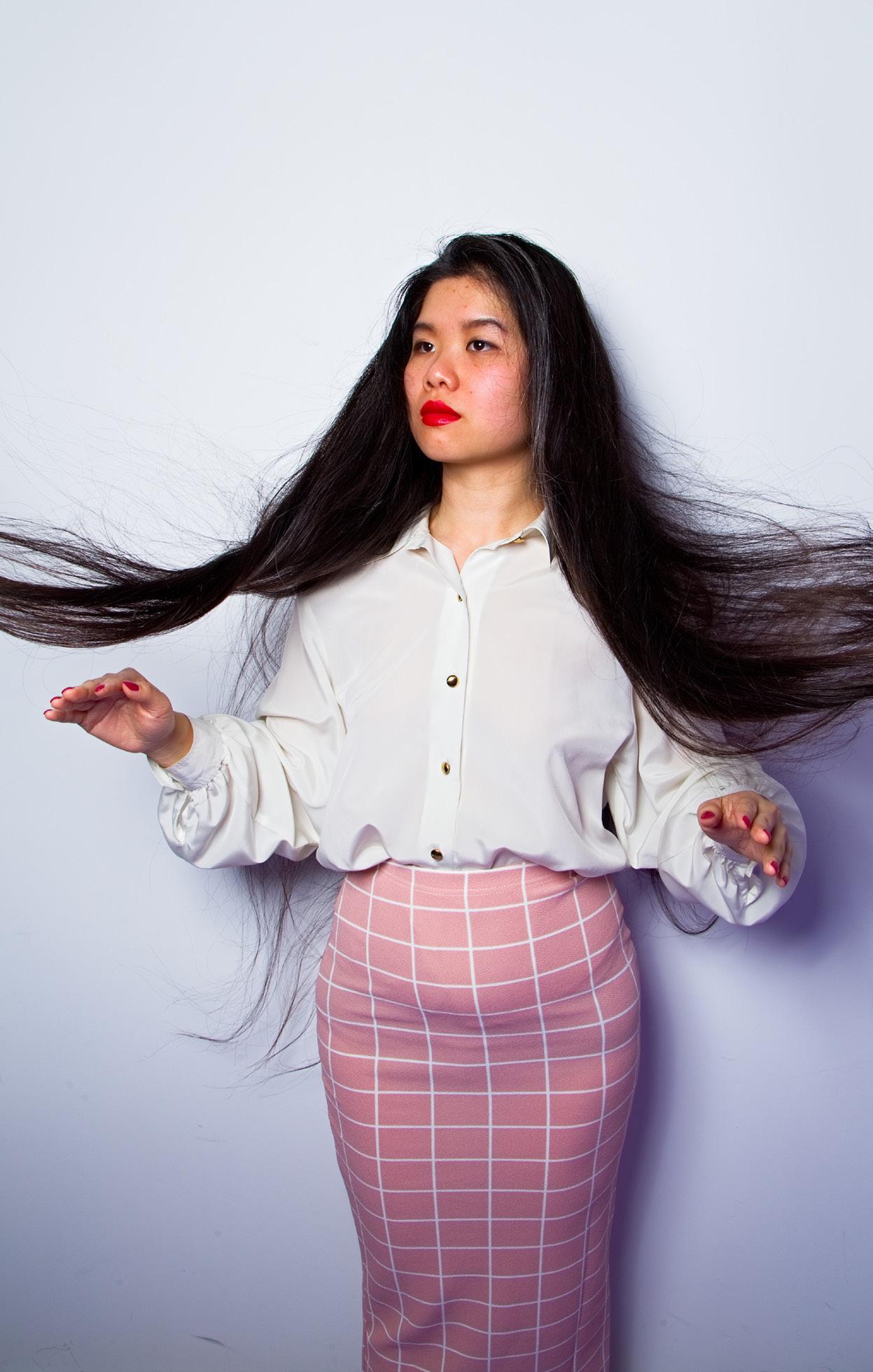
was kicked into a space where I started questioning who I was. If he’s not around then, who am I?”
Due to school and the visa, Tsz was unable to go back to Hong Kong for the funeral.
“I recently talked to a friend about this. They lost their loved one in a traumatic way, but I don’t necessarily feel like what I went through was traumatic. Yeah, it was sad and difficult to not be there, but he meant so much to me, and I internalized this idea that I’m supposed to continue doing everything he wanted me to do. Spiritually I’m okay. I’m not sad in any way. I feel like he’s always with me.”
After graduating high school Tsz got accepted into the University of Texas. They moved to Austin and began majoring in studio art. Their inspiration for becoming an artist was very similar to the majority of creative kids who grew up in the ‘90s.
“It sounds cliche coming from an Asian but anime and comic books really inspired my art. They told stories, and I’m a fan of

being able to tell a story visually. I’m not really into anime anymore, but when I was younger I was really into Fullmetal Alchemist. Dragon Ball Z too. My mom actually watched Dragon Ball Z when I was in the womb, so maybe that had some influence in utero. I remember thinking, Mom? Aren’t you supposed to listen to Mozart or something? haha. But I guess Dragon Ball Z worked.”
The transformation that Tsz was going through entering college was giving them perspective on their art. After losing their grandfather and trying to adapt to college in a new city, Tsz wasn’t really prepared for what the next few years would hold.
“I don’t know what I was expecting what college life would be like. I was amazed at all the parties. I didn’t understand it. I thought, Hey, aren’t we supposed to be here to learn? Why is everyone partying? Until this day I don’t understand fraternities. I also was amazed at all the white people in Austin. Coming from Houston and a school that was pretty diverse, going to college was my first experience with culture shock.”
Like most artists, college becomes a defining moment. A place where artists can work on their talent and abilities while discovering their style. For Tsz, the timing of that would be almost too perfect. During college, Tsz would constantly find new things about their identity, from their queerness to how society would see them. It translated well in their art.
“When I was in college, I started investigating my self-image and how it related to my identity, being perceived as an Asian American woman, all of the stereotypes that are associated with it and how I feel about it. I was confronting myself, what I looked like to myself. As a child in Hong Kong, I was always told that I wasn’t pretty. Thats a big reason why I focused on my studies, and I did well because I got a lot of push back on my image: Well, if people think I’m ugly, then I’ll just focus on being the best in everything else.”
They look back on it now and realize it has had an impact on how they view themselves. The culture saw their monolids as not as attractive, and their overall facial structure not as pleasing. Something so specific has an effect on young girls which has led to generations of women struggling with their image. Feeling like women don’t have options for themselves, that how they look has already been formed into
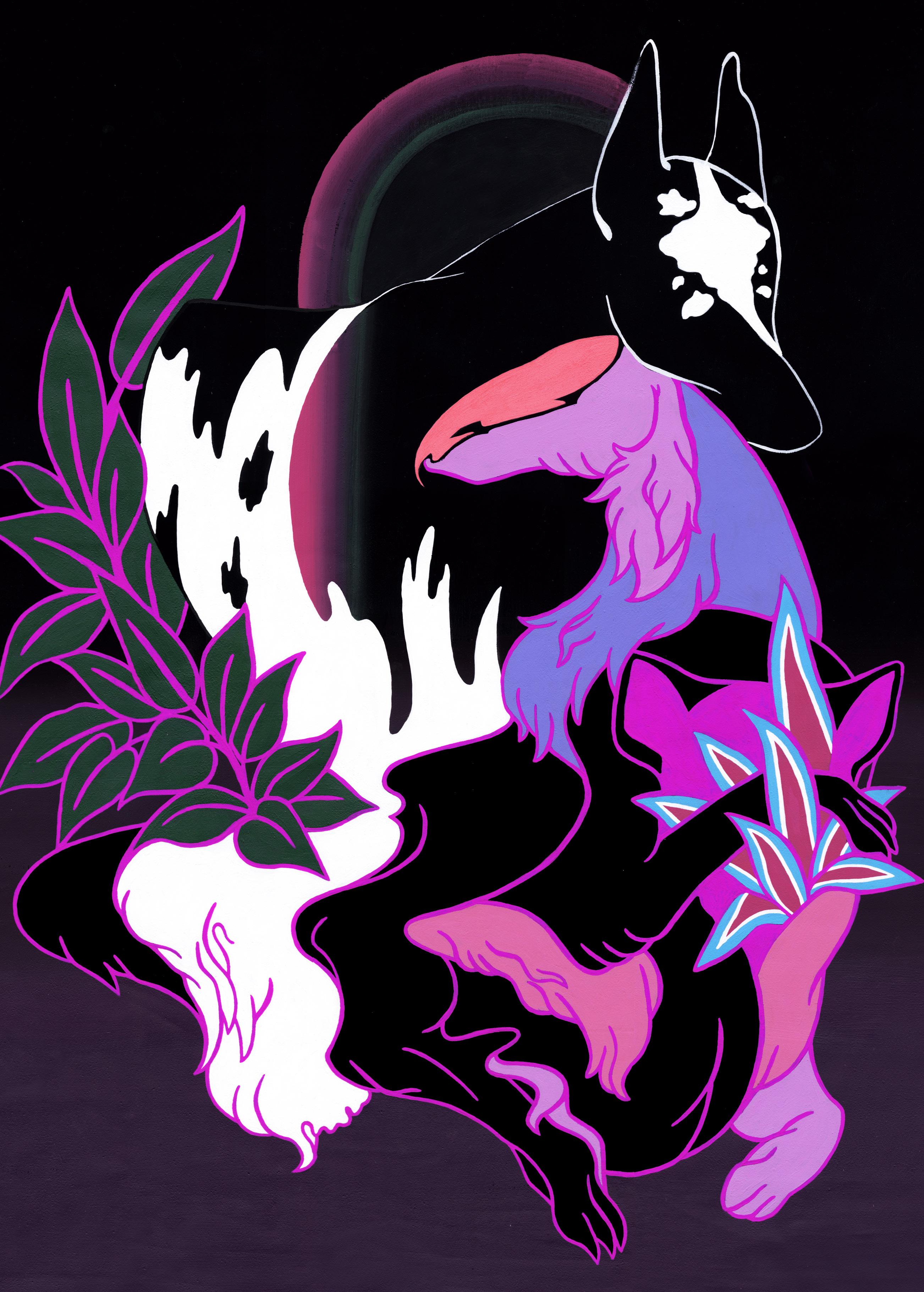
their brain, and they can’t think past it. Even though Tsz saw it as negative, it wasn’t going to change their path. It wasn’t going to change them. It shows up in their art, but it may not be as obvious as you think.
“People aren’t getting it. I felt like each time people saw my art, they didn’t seem to understand what I was trying to say about my self-image. I start off by putting my figure out there, but sometimes when people see a nude woman, they tend to associate it with something else, or they over-analyze it. I was tired of trying to explain it so I wanted to create a symbol to replace my figure. I wanted it to be funny. I was like well a macaroni is yellow. Asian people’s skin is referred to as yellow. A bunch of macaroni look all the same, so do Asian people. There’s two holes. If you get right down to it, humans are just two holes interconnected. We’re just a tube.”
After Tsz explains to me the macaroni symbol, I can’t help but laugh. The whole time I just thought it was their favorite food. Having them explain to me what it stood for was interesting and gave me insight into their vision. Their art was about their identity, but from different perspectives. It was fun, but also a stereotype. It was serious and also sad. It was a discovery in who they were and who they were becoming.
“I’m a visual artist, so I think of aesthetics first. I always go with what looks nice. I don’t always put symbolism in there, but when I do, it comes second to how it looks. I get inspired by what I’m reading, or things I’m into at the time so my art can change over a small period of time. I enjoy having people look at it and see something different each time. Makes me feel like I’m doing something right.”
We somehow talk about other subjects that don’t pertain to the questions I wrote down, but I go with it. It’s over an hour now and I don’t really want to stop talking. We talk about psychedelics and how we both have never tried them. Our argument is the same. What’s the point? Life is already a trip. We then start talking about other dimensions, and how we have found ourselves in this unique one. The conversation leads to Tsz showing me a book they are currently reading by Ursula K. Le Guin called Cheek by Jowl: Talks and Essays on How & Why Fantasy Matters. They want to read me an excerpt from the book. They think it will fit in really nicely with the theme of the issue.

“The monstrous homogenization of our world has now almost destroyed the map, any map, by making every place on it exactly like every other place, and leaving no blanks. No unknown lands. A hamburger joint and a coffee shop in every block, repeated forever. No Others; nothing unfamiliar. As in the Mandelbrot fractal set, the enormously large and the infinitesimally small are exactly the same, and the same leads always to the same again; there is no other; there is no escape, because there is nowhere else.
In reinventing the world of intense, unreproducible, local knowledge, seemingly by a denial or evasion of current reality, fantasists are perhaps trying to assert and explore a larger reality than we now allow ourselves. They are trying to restore the sense— to regain the knowledge— that there is somewhere else, anywhere else, where other people may live another kind of life.
The literature of imagination, even when tragic, is reassuring, not necessarily in the sense of offering nostalgic comfort, but because it offers a world large enough to contain alternatives and therefore offers hope.
The fractal world of endless repetition is appallingly fragile. There is no illusion, even, of safety in it; a human construct, it can be entirely destroyed at any moment by human agency. It is the world of the neutron bomb, the terrorist, and the next plague. It is Man studying Man alone. It is the reality trap. Is it any wonder that people want to look somewhere else? But there is no somewhere else, except in what is not human— and in our imagination.”
Tsz puts the book down and I find it to be a perfect end. I thank them for the lunch and the wonderful conversation. Before I leave, they show me some of their art for the next show called Step into the Water and You Remember Everything. It’s a collabrotive effort with their creative partner Nat Power. Nat and Tsz (also known as Big Chicken & Little Bird) have been friends since college and have worked together on many projects. Nat is currently pursuing an apprenticeship at a local tattoo shop and likes to keep a low profile. They are working hard to meet their deadline for their opening reception on March 6th. I try not to keep them any longer and see my way out. Before I grab my stuff and head out the door they catch me and say, “Wait, you almost forgot the macarons! Take as many as you want!”
“Tsz” was given to me by a fortune teller my parents took me to, it is my legal name and often a boy’s name. However, my grandfather gave me a different name that is in our family’s genealogy book, which is Sui Mui. It means “snow plum blossom”. He named all the girls in my generation with the suffix “plum blossom” because that is the national flower of the Republic of China aka Taiwan, the only place on Earth where a majority Sino population live under a democratic system. Plum blossoms bloom the most vibrant in winter, it is a symbol for resilience and perseverance in the face of adversity.
